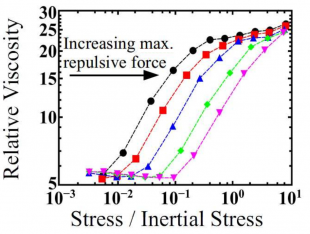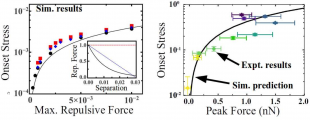Models and numerical simulations play an important role in understanding the mechanisms as well as exploring parameter space. Working with a recently established framework [1], where suspension viscosity is controlled by forming frictional contacts, we investigate how particle contact properties change suspension rheology. In particular, we use discrete element methods (DEM) to investigate the effects that adding short-ranged pairwise particle repulsive interactions has on the rheology of these granular dense suspensions [2]. Recent experiments using charge-stabilised particles suggest that increasing short-ranged particle-particle repulsion results in an increase in onset stress.
Our work using DEM simulations corroborates these findings, and attributes the observed increase in onset stress solely to increases in the peak force of the short-ranged repulsion. Other factors, such as charge-screening lengths, were found to have little to no effect on the onset stress. Furthermore, we show that the onset stress is linearly correlated with the peak repulsive force and that this linear correlation holds regardless of the repulsive force profile used. Lastly, the linear correlation observed in simulations matches experimental results perfectly. Currently, we are researching the effects that adding short-range particle attractions and particle adhesion (resistance to rolling) has on suspension shear rheology.
References
[1]M. Wyart and M. E. Cates. Discontinuous shear thickening without inertia in dense nonbrownian suspensions. Phys. Rev. Lett., 112:098302, 2014.
[2]N. Y. C. Lin, B. M. Guy, M. Hermes, C. Ness, J. Sun, W. C. K. Poon, and I. Cohen. Hydrodynamic and contact contributions to continuous shear thickening in colloidal suspensions. Phys. Rev. Lett., 115:228304, Nov 2015.




